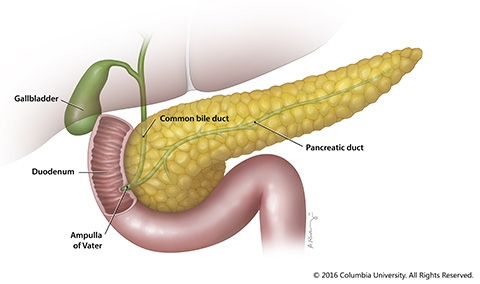What Are The Size And The Location Of The Pancreas?
The Pancreas and Its Functions
Location of the Pancreas | Functions of the Pancreas | Diseases of the Pancreas | Next Steps
 The pancreas is an organ located in the belly. It plays an essential office in converting the food we consume into fuel for the body'southward cells. The pancreas has two main functions: an exocrine function that helps in digestion and an endocrine role that regulates claret carbohydrate.
The pancreas is an organ located in the belly. It plays an essential office in converting the food we consume into fuel for the body'southward cells. The pancreas has two main functions: an exocrine function that helps in digestion and an endocrine role that regulates claret carbohydrate.
Location of the Pancreas
The pancreas is located backside the tum in the upper left belly. It is surrounded by other organs including the small intestine, liver, and spleen. It is spongy, near six to 10 inches long, and is shaped like a flat pear or a fish extended horizontally beyond the abdomen.
The broad part, called the head of the pancreas, is positioned toward the heart of the abdomen. The head of the pancreas is located at the juncture where the tummy meets the get-go part of the small intestine. This is where the stomach empties partially digested food into the intestine, and the pancreas releases digestive enzymes into these contents.
The key section of the pancreas is called the neck or body.
The thin end is called the tail and extends to the left side.

Several major blood vessels surround the pancreas, the superior mesenteric artery, the superior mesenteric vein, the portal vein and the celiac axis, supplying blood to the pancreas and other abdominal organs.

Almost all of the pancreas (95%) consists of exocrine tissue that produces pancreatic enzymes for digestion. The remaining tissue consists of endocrine cells called islets of Langerhans. These clusters of cells look like grapes and produce hormones that regulate blood sugar and regulate pancreatic secretions.
Functions of the Pancreas
A healthy pancreas produces the right chemicals in the proper quantities, at the correct times, to digest the foods we swallow.
Exocrine Function:
The pancreas contains exocrine glands that produce enzymes important to digestion. These enzymes include trypsin and chymotrypsin to digest proteins; amylase for the digestion of carbohydrates; and lipase to break down fats. When nutrient enters the stomach, these pancreatic juices are released into a organization of ducts that culminate in the chief pancreatic duct. The pancreatic duct joins the common bile duct to course the ampulla of Vater which is located at the first portion of the small intestine, called the duodenum. The common bile duct originates in the liver and the gallbladder and produces another important digestive juice called bile. The pancreatic juices and bile that are released into the duodenum, help the body to assimilate fats, carbohydrates, and proteins.
Endocrine Function:
The endocrine component of the pancreas consists of islet cells (islets of Langerhans) that create and release of import hormones directly into the bloodstream. Two of the chief pancreatic hormones are insulin, which acts to lower blood carbohydrate, and glucagon, which acts to raise blood sugar. Maintaining proper blood sugar levels is crucial to the functioning of cardinal organs including the brain, liver, and kidneys.

Diseases of the Pancreas
Disorders affecting the pancreas include pancreatitis, precancerous atmospheric condition such as PanIN and IPMN, and pancreatic cancer. Each disorder may exhibit unlike symptoms and requires different treatments.
Pancreatitis
Pancreatitis is inflammation of the pancreas that occurs when pancreatic enzyme secretions build up and begin to digest the organ itself. It tin occur equally astute painful attacks lasting a thing of days, or it may be a chronic condition that progresses over a flow of years.
Learn more almost pancreatitis, its causes, and handling options.
Precursors to Pancreatic Cancer
The exact cause of pancreatic cancer is still unknown, but in that location are known risk factors that increase the chance of developing the disease. Cigarette smoking, a family history of pancreatic cancer or hereditary cancer syndromes, and chronic pancreatitis are some of these factors. In improver, certain pancreatic lesions such as Intraductal Papillary Mucinous Neoplasms (IPMNs) and Pancreatic Intraepithelial Neoplasia (PanIN) are considered precursors to pancreatic cancer.
Read more about the precursors to pancreatic cancer.
Pancreatic Cancer
The well-nigh common form of pancreatic cancer is pancreatic adenocarcinoma, an exocrine tumor arising from the cells lining the pancreatic duct. A far less common form, endocrine tumors, account for less than 5% of all pancreatic tumors and are sometimes referred to as neuroendocrine or islet cell tumors.
Learn more virtually different forms of pancreatic cancer and their treatments.
Next Steps
If you lot or someone you care for is dealing with a pancreatic condition, the Pancreas Center is hither for you. Whether you demand a diagnosis, treatment, or a second stance, we take an unabridged team of experts ready to help.
Call united states at (212) 305-9467 or use our online form to go far touch today.
Related Services
- Pancreatic Cancer Care Programme
- Pancreatitis Program
See all Programs & Services »
Related Topics
- Pancreatic Cancer
- Pancreatic Cysts
- Pancreatitis
- Pancreatectomy
- Chemotherapy for Pancreatic Cancer
- Endoscopic Treatment for Pancreatic Illness
- Non-Invasive Tests for Pancreatic Cancer
- Palliative Procedures
- Surgery for Pancreatic Cancer
- Whipple Procedure (Pancreaticoduodenectomy)
- Total Pancreatectomy with Autologous Islet Cell Transplantation
See all Related Topics »
What Are The Size And The Location Of The Pancreas?,
Source: https://columbiasurgery.org/pancreas/pancreas-and-its-functions
Posted by: pricebrity1982.blogspot.com


0 Response to "What Are The Size And The Location Of The Pancreas?"
Post a Comment